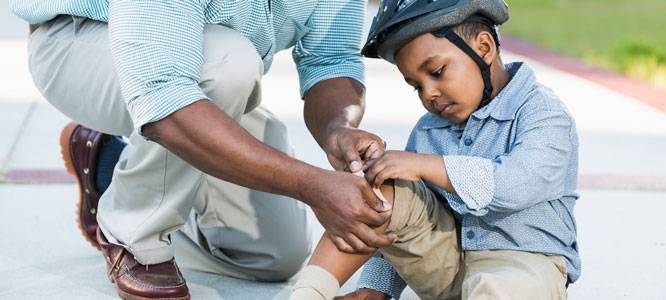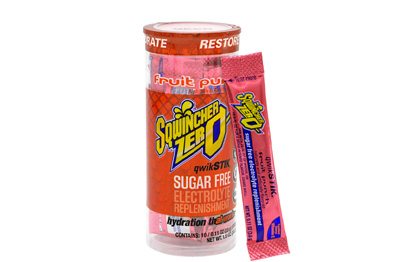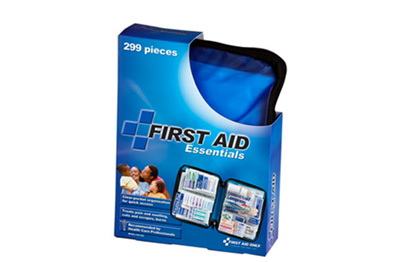
Safety Hacks for EveryoneMonday, June 20, 2016 Being prepared for any situation is the ideal scenario, but it's hardly always the reality. Life is full of surprises that range from neat or exhilarating to mildly annoying and, of course, downright awful. Preparing for the big stuff can take time and might require more time and money than you're prepared to spend. But whether you're already prepared for the big emergencies or you're still in the process of making a list, here are a few of our favorite easy safety tips that everyone should know today. Make Your Own Rehydrating Solution
An oral rehydration solution (or ORS) can be purchased at most pharmacies, and you might even have a few packages stocked away in your safety kit already, but did you know that the recipe for a DIY ORS requires just a couple of ingredients?
Forget the Tweezers or the NeedleWe've all been there: while walking barefoot, doing yard work or moving furniture, you hit a snag, literally. A small splinter of wood gets lodged in your palm, the tip of your finger or in the ball of your foot. It's painful, but so is the thought of digging it out with a pair of tweezers or a needle. Don't worry; you're not the first to think so. Plenty of independent research has been done on the removal of splinters, from soaking the area to applying common household items or even foods. While we can't back many of these claims with our own experiences, we do know that there are two common household products that will work in most cases for painless splinter removal without the use of tweezers or needles. Glue To utilize this method for extraction of splinters, first you must ensure that your glue is non-toxic. Furniture glue, wood glue, superglue or rubber cement are not options here.
This trick is especially helpful with small children who will likely squirm or fuss even at just the site of tweezers or a needle and are familiar with the benign qualities of glue. Duct Tape You've always had your suspicions, and this seems to confirm it: Duct tape will fix anything. The beauty behind using duct tape to remove splinters is that you're likely already well stocked whereas tweezing or sewing may simply not be your style. Using duct tape to remove your splinter works a lot in the same way as using glue.
Increase Your Visibility
Whether you're in your own neighborhood or trekking through unknown territory, we believe that the best way to take yourself out of harm's way before you're in it is to remain visible. From reflective clothing to LED lighting, there are plenty of easy and affordable options that will have motorists looking twice before turning into you.
If you're a regular walker, runner or cyclist, we recommend that you equip yourself with highly visible safety gear such as a vest, reflective strips or LED lighting you can clip onto belts, hats or backpacks.
Know Your SurroundingsIt's true in all scenarios: Knowing where you are in respect to your surroundings can be life-saving. From hiking adventures to walking alone at night, we take the proper precautions to ensure that we remain well aware of where we are. But many of us have come accustomed to the idea of the inevitable blind spot while we're on the road. Your blind spot can easily keep other motorists and cyclists out of your line of sight, creating the perfect opportunity for a tragedy. Many newer cars already come equipped with a blind spot mirror, but you don't have to trade in your vehicle just yet to create a safer ride for yourself and for other motorists. Self-adhesive blind spot mirrors are available at major auto shops, Sears and even through Groupon. Their low cost and easy installation makes this a smart investment all around. Become a First-Aid Expert
First-aid can be as easy as 1-2-3, and being equipped to handle a minor emergency is one of our favorite hacks of all. Knowing proper first-aid will prepare you to deal with burns, cuts, bone breaks and more.
|


 If you or a loved one are struck with serious vomiting or diarrhea, or if you've lost water rapidly through severe sweating caused by high temperatures or above-average strenuous activity, rehydrating properly is vital. Water alone will dilute bodily fluids and compromise the body’s internal balance of electrolytes and sugars, which is where a rehydration solution comes in.
Dehydration is marked by dark yellow or brownish urine, decreased or absent urination, thirst, headache, dry or hot skin, dizziness, confusion, and lethargy. If you or a loved one are experiencing these symptoms, especially in conjunction with vomiting or diarrhea, a rehydration solution is likely necessary.
To prepare your own ORS, all you need is salt, sugar and clean water. To make 4 cups of ORS, combine 6 teaspoons of sugar with .5 teaspoons of salt. Note that the ratio of sugar to salt is 12:1 - keep this ratio in mind in the event that measuring utensils aren't available and you have to guess.
Remember that although sugar is added to our solution, dehydration cannot be tackled using sugar alone. Therefore, it is important to avoid juices, sodas or other sugary drinks when dehydrated. Known diuretics such as tea, coffee, energy drinks and alcohol should also be avoided at all costs to prevent further dehydration.
If you or a loved one are struck with serious vomiting or diarrhea, or if you've lost water rapidly through severe sweating caused by high temperatures or above-average strenuous activity, rehydrating properly is vital. Water alone will dilute bodily fluids and compromise the body’s internal balance of electrolytes and sugars, which is where a rehydration solution comes in.
Dehydration is marked by dark yellow or brownish urine, decreased or absent urination, thirst, headache, dry or hot skin, dizziness, confusion, and lethargy. If you or a loved one are experiencing these symptoms, especially in conjunction with vomiting or diarrhea, a rehydration solution is likely necessary.
To prepare your own ORS, all you need is salt, sugar and clean water. To make 4 cups of ORS, combine 6 teaspoons of sugar with .5 teaspoons of salt. Note that the ratio of sugar to salt is 12:1 - keep this ratio in mind in the event that measuring utensils aren't available and you have to guess.
Remember that although sugar is added to our solution, dehydration cannot be tackled using sugar alone. Therefore, it is important to avoid juices, sodas or other sugary drinks when dehydrated. Known diuretics such as tea, coffee, energy drinks and alcohol should also be avoided at all costs to prevent further dehydration.









